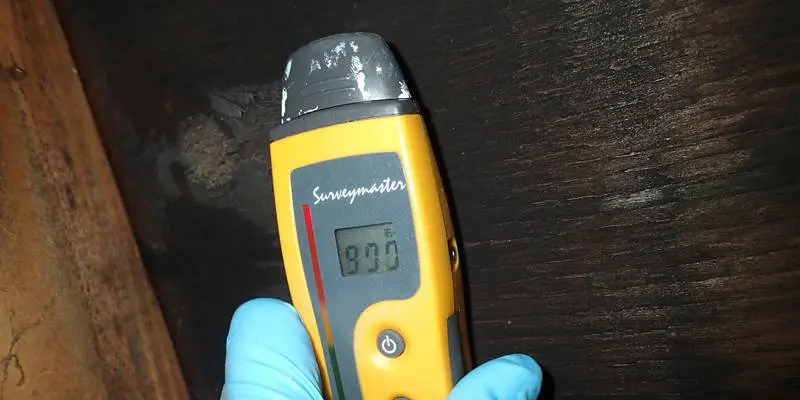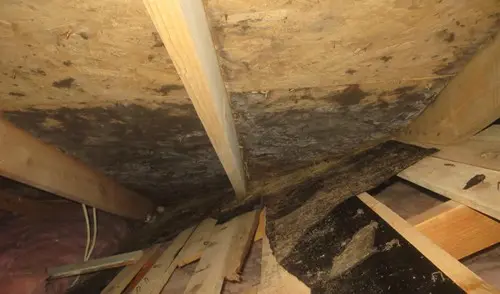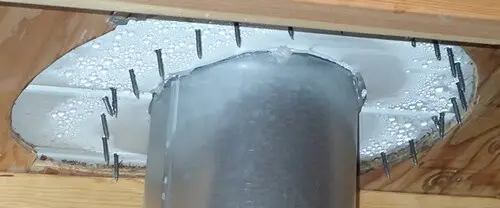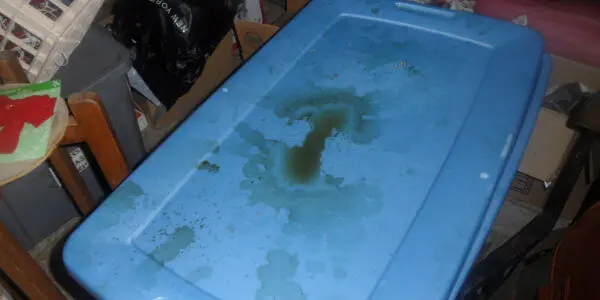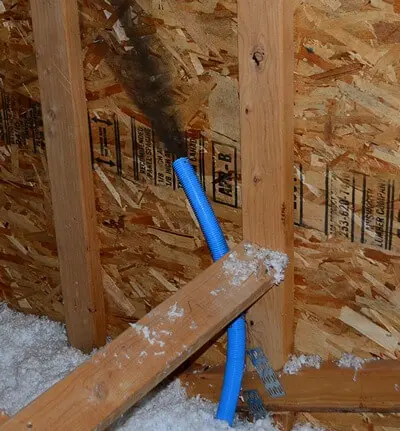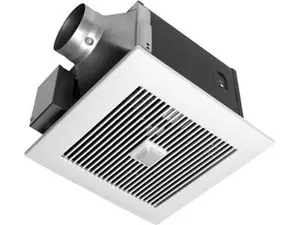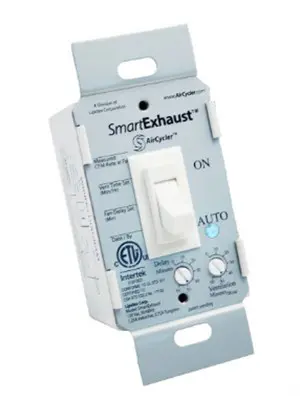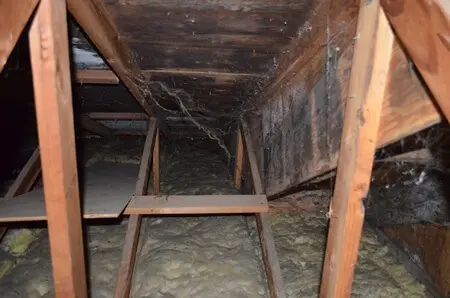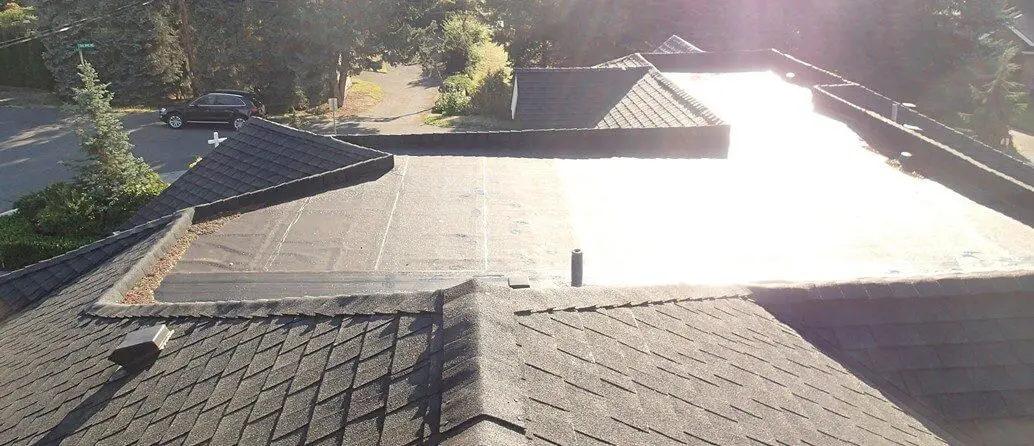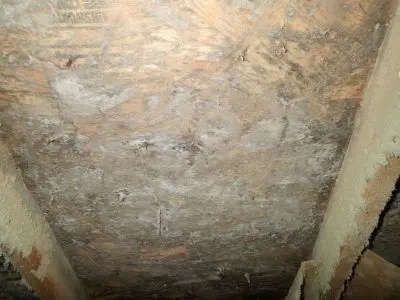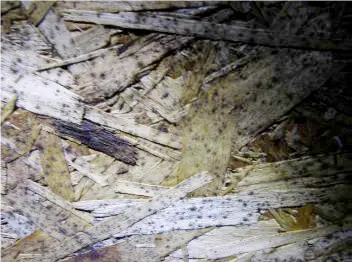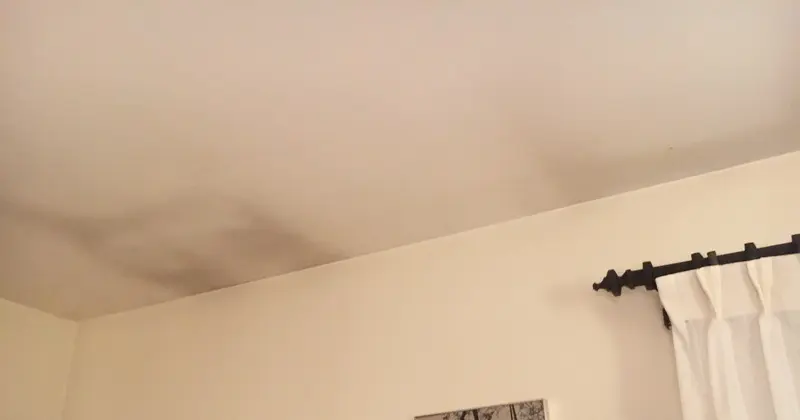Attic Mold Growth - How to Avoid the Scams and Find Permanent Solutions
First, is it really attic mold?
Attic mold growth comes in a wide variety of colors and growth patterns, some of which are often misdiagnosed. Fuzzy /3-dimensional mold growth is nearly always identified correctly. When the growth pattern is very flat and appears like staining, it can cause confusion.
Low profile mold staining

Uniform black mold growth on attic sheathing
3 dimensional spotting

White and green fuzzy growth on OSB sheathing
Roof leak vs. condensation – Determining the cause of attic mold.
Despite what your roofer would like you to believe, roof leaks rarely cause significant mold problems. Why? Roof leaks are obvious. It’s pretty hard to miss water dripping through your ceiling. Because of this, people usually address their roof leaks quickly – long before mold growth can occur. Also, roof leaks occur in one area (again, despite what your roofer will tell you). They do not leak en masse. Even if a roof leak goes undetected long enough to cause mold growth, the problem will be localized to a small area directly around the leak. 95%+ of attic mold growth issues are due to condensation.
Why the confusion? Heavy condensation can look a lot like a roof leak.
During cold periods, condensation can become so severe that moisture will drip from the sheathing. This can often fool home inspectors and homeowners into believing they have a roof leak. The moisture in the image below is entirely due to condensation. Yet many inspectors and roofers would point toward a roof leak. Unfortunately it is a costly error. Once a roofer is called to investigate, you can rest assured they will determine you need a new roof…
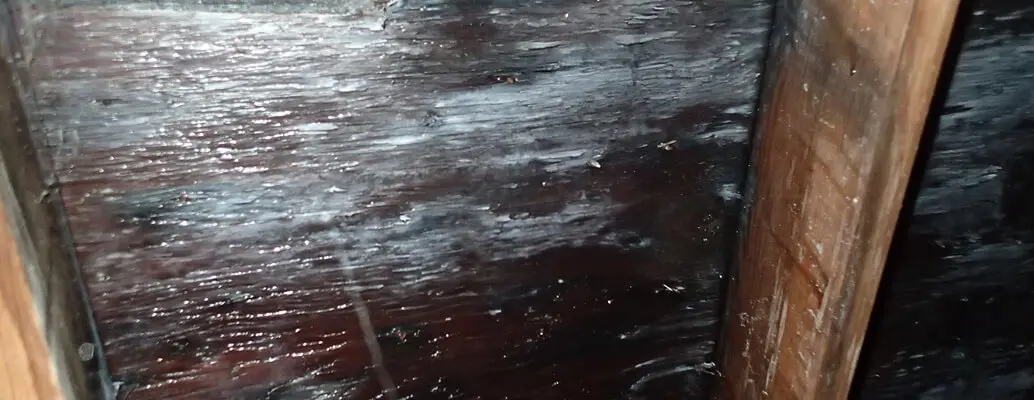
Water from a roof leak? Nope – condensation.
Even a moisture meter can’t differentiate between the two. During cold weather, a poorly vented attic can easily turn completely saturated, as shown in the image below. No leak, just humidity interacting with the cold roof sheathing.
Is the moisture and mold growth systemic or limited?
The first clue is whether the mold and moisture issues are affecting large areas of the roof. If so, it’s due to condensation. Roof leaks don’t occur systemically throughout an entire roof assembly. You might have two or three failure points in an extremely rare scenario, but these would still only affect a small area. Below is a typical roof leak. The mold growth and sheathing damage is limited to a small area. Additionally, there is a clear entry point at the gap between the two sheets of plywood.
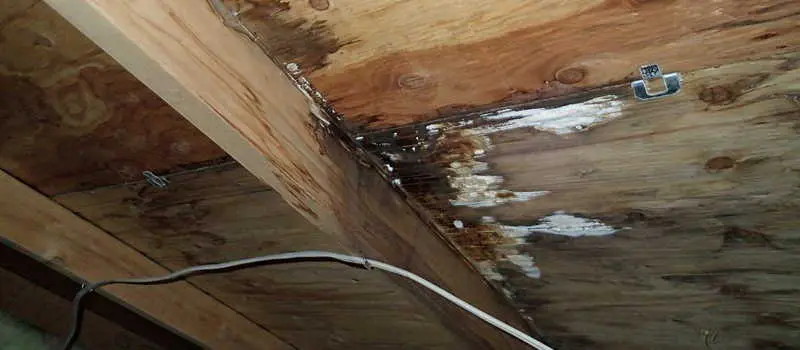
Roof leak with localized damage.
Mold growth due to condensation typically affects large swaths of the attic. Sometimes you’ll find limited growth around a disconnected bathroom exhaust fan, but in general the growth is uniform throughout the space. Below is a typical growth pattern for condensation based mold damage.
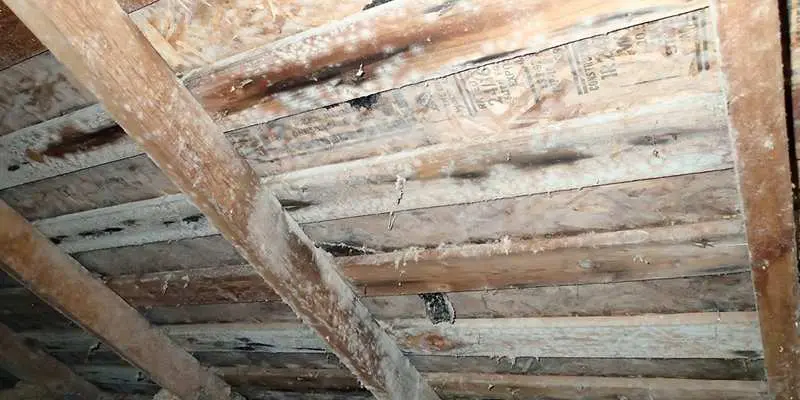
Mold due to condensation – typically systemic throughout the attic.
Is the mold heavier on the north side of the roof?
Condensation will typically be much worse on the north side of the attic. In the winter, the sun will not reach the northern aspect of the roof, leading to cooler temperatures and higher rates of condensation. Heavier growth on the north side is strong evidence of condensation rather than a roof leak. Notice the complete absence of mold growth on the south side (left) of the roof in the in photo below.
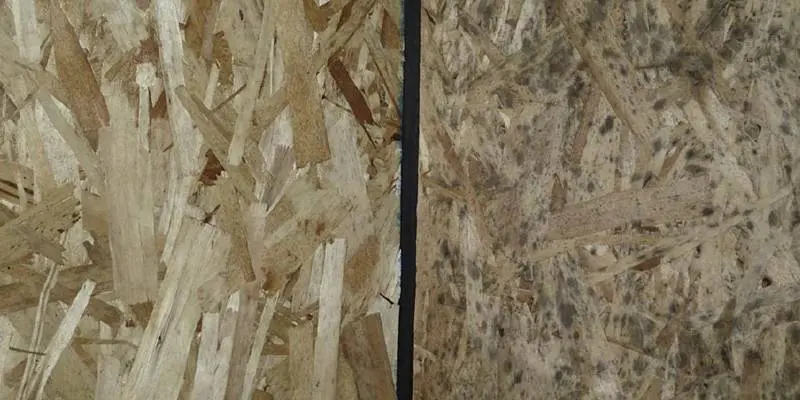
Mold growth affecting the north side of the roof.
Check above the garage
This is perhaps the easiest trick. If a roofer tells you the entire roof is failing, than it should be equally wet above the garage, right? 9 times out of 10 you’ll find the sheathing above the garage is perfectly clear and dry. This is clear proof you’ve got a condensation issue, not a failed roof. Why? Condensation doesn’t occur above a garage. Since the garage isn’t occupied, there’s no moisture source below. You need people (showering, cooking, breathing, etc.) to generate moisture, which migrates upward and causes condensation.
Tricky scenarios – Mold growth in attic valleys
Below is an image of heavy mold growth in a valley (where two roof sections meet). This often causes confusion, as these sections of the roof do commonly leak. However, they are also areas of poor circulation and therefore, condensation based mold. The best way to determine the source is to examine the attic during a period of cool, dry weather. A roof leak will stop but condensation will get worse.
Clues that point to condensation instead of roof failure/leaking:
- Inspect the attic during a cold, dry stretch. If it’s wet, you’ve got proof of condensation.
- Mold/moisture is worse on the north side of the roof. The lack of sun exposure will increase condensation and mold growth.
- Water droplets on the nails. This occurs because the metal nail is much colder than the surrounding wood sheathing. This causes condensation to form here first. If water droplets are found on a large amount of the nails, you’ve got condensation, not a leak.
- Mold growth / moisture above the occupied part of the house, but not the attic. (since rain falls equally on the garage roof vs the main house, we would expect the moisture to be equally severe. If it’s much wetter above the occupied part of the house, we know it’s from condensation.
What is condensation?
Condensation occurs when the temperature of a surface of a material reaches the dew point. This means the air is 100% saturated and cannot hold any more water molecules. Once this occurs, the water molecules begin to condense on anything that is less saturated. In an attic, this is typically your roof sheathing or framing. Usually you cannot see the individual droplets unless there is an exposed area of metal or the outside temperature is especially cold.
The photo below illustrates where condensation comes from in an attic. This attic had a vapor barrier installed on top of the insulation (this is not a good idea). As the vapor moves up from the interior of the home it passes through the sheet rock and penetrations in the ceiling. In a typical attic, this vapor moves through the insulation and into the attic space, eventually condensing on the underside of the roof sheathing. Or, if the attic is operating correctly, the moisture is vented to the exterior through roof vents. Because the poly sheeting seen in the photo is vapor impermeable, the moisture could not pass through.
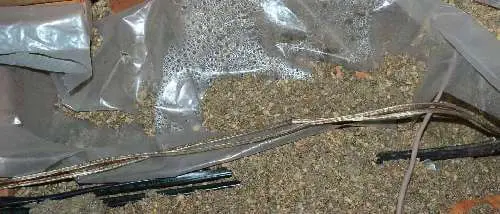
Condensation occurring on the underside of plastic in the attic.
If the condensation is really severe, you’ll see drip marks on the surfaces below. In this case the attic was used for storage (never a good idea) which provided dramatic evidence of the condensation and dripping.
If condensation lingers long enough, the mold spores will begin to grow. Many people think mold growth is prevented by eliminating the mold spores themselves. This would be great if it were true. But mold spores are ubiquitous. Even if you managed to kill all the mold spores in an attic, a thousand new spores would drift in within hours and settle on top of your nice clean surface. The photo below provides a dramatic example of why mold growth occurs in an attic. The triangular section without mold has a secondary roof line behind/above it. This creates a warm pocket of air, eliminating the condensation.
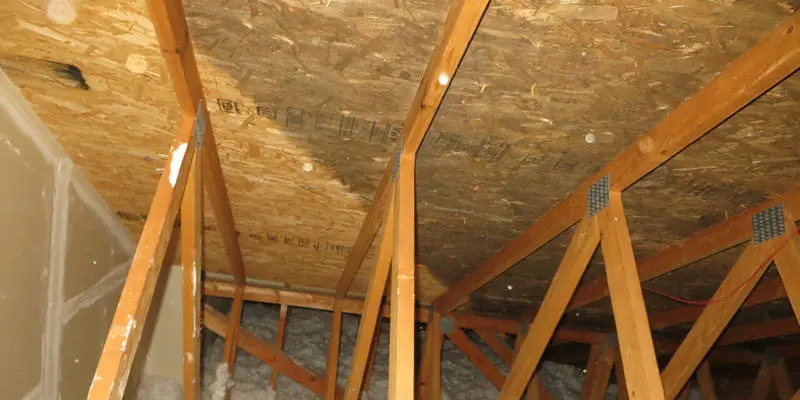
Mold growth due to condensation.
Identifying the roof cause of attic mold
This is where it gets tricky. Because the majority of attic mold cases are caused by condensation, it means you’ll rarely find a smoking gun. Typically the condensation is caused by several compounding factors. There are two main factors that cause condensation.
- Excessive moisture entering the attic from the attic space below.
- Insufficient ventilation in that attic.
If one of these factors is operating poorly, an attic might avoid mold growth by succeeding well in the other factor. For example, if a house has poor attic ventilation, but the ceiling is well air sealed and the interior of the home has excellent ventilation, mold growth will not likely occur. The opposite is true, but too a lesser extent. Homes with excellent roof venting can overcome poor air sealing but if the interior RH is high, mold growth will override the venting and mold growth will occur.
PROBLEM #1.) Excess moisture transport from the home into the attic
In most cases, the moisture that causes the condensation on the roof sheathing is from occupant activity in the home below. Showering, cooking, laundry, even just breathing adds water vapor into the air. Due to the stack effect (warm air rising), this moisture slowly migrates toward the attic. This is why you rarely find mold growth in the attic above a garage or a rarely used portion of the home.
Notice how the dark line on the insulation in the photo below line up with the top plate. As air leaks migrates from the home into the attic, it carries soot and dust particles. The insulation traps these particulates, causing the staining. While the staining itself is harmless, it points to a major air leakage issue.
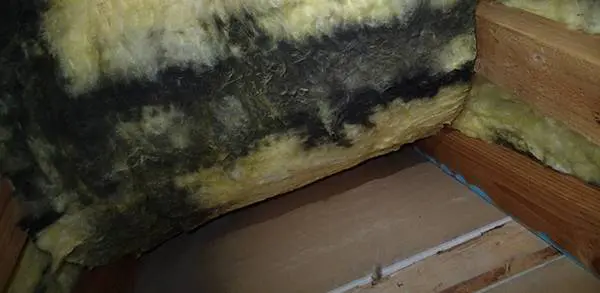
Soot & particulate deposits due to air leakage.
Some of the moisture movement occurs directly through the building materials, such as sheet rock. This is why building codes often require a vapor retarder on the ceiling. In the past this was accomplished via tar facing on the the fiberglass batts. Many builders now simply use a paint/primer with a low perm rating to act as the vapor retarder. While this is a nice touch, the vast majority of moisture transport comes through air movement. This occurs when air flows through penetrations in your ceiling (can lights, fans, etc.) and top plates (holes for electrical wires). As the air flows through these holes into the attic, it pulls the moisture as well.
The result? The vast majority of condensation is due to air movement transporting the water vapor rather than the water vapor directly moving through the sheet rock ceiling. Below is a dramatic shot of this principle in action. The blue piping is unsealed in the house, allowing warm, moist air to move into the attic space. Once it hit the cold gable wall of the attic, the moisture immediately condensed on the surface, leading to mold growth. While it is rarely this visibly dramatic, this same principle is behind the majority of attic mold problems.
Air leakage around sky lights
This is another example of an area that commonly suffers from actual roof leaks (flashing around the skylight). And yet because these skylights are often located up in a dead end air space, air leakage into the attic can be severe. The issue is also exacerbated when the skylights are located in a bathroom, which suffers from dramatically higher moisture loads.
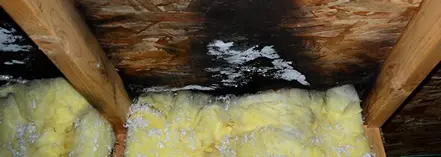
Looks like a roof leak, but this is actually due to air leakage
Ironically, if a home is well sealed everywhere (windows, siding, etc.) this can actually make problems worse, because the natural dissipation and dilution of excess moisture does not occur. Even in a well sealed ceiling, the moisture, finding no other pathway, will eventually makes it way into the attic. If you’re going to seal your home, ensure the ceiling / attic junction is sealed better than the walls and windows. Most homes are poorly sealed and therefore require substantial ventilation.
Unsealed gaps between condo partition walls
Below is an image of mold growth (and condensation) from unsealed air gaps around the perimeter of the attic. The air gaps were between adjacent condo units, which allowed large quantities of moist air to migrate up into the attic space.
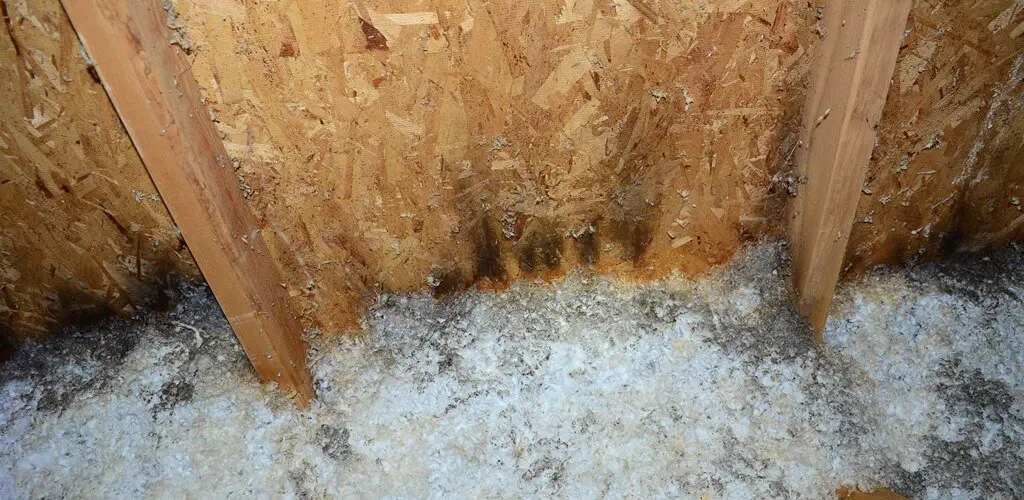
Mold growth on attic partition walls in condo complex.
Solutions – Improve your bath fan
The easiest and often most effective way to lower the humidity in the attic is to reduce the humidity within the home. As noted above, the mold problems in your attic are due to the upward movement of humid air from the interior of the home into the attic. Therefore, the best way to fix this is to lower the humidity inside the home.
This is why you almost never see mold above a garage. There’s no humidity source below it. Installing the fan lowers the indoor humidity (via the bath fan), which in turn lowers the humidity of the attic.
The bath fan accomplishes this by drawing in cool, wet air during the winter months. Initially this air is humid. But after it is heated by your HVAC system, the humidity lowers dramatically, even lower than the existing air in your home. If you place an RH gauge on your home, you’ll see this effect. The more you run an exhaust fan, the lower your humidity will become.
Option 1 – replace the fan
If your fan is old or ineffective, you’ll need a new fan. We recommend Panasonic WhisperGreen units. These fans operate continuously throughout the day at a low speed setting. When the bathroom is occupied, they automatically ramp up to full speed to handle the increased humidity. These fans can also be purchased with a humidity sensor, but these are often ineffective. The motion sensor model is much better.
If your fan is in good shape and relatively quiet, you can swap out the switch with an automated timer version. We recommend the Smart Exhaust by AirCycler. This allows you to program the fan to switch on and off throughout the day.
PROBLEM #2.) Poor ventilation of the attic assembly
The need for ventilation in the attic is directly related to the amount of moisture coming from the occupied spaces below. If the house has an extremely well sealed ceiling / attic floor junction, very little moisture will enter the attic from the home. Minimal ventilation will be necessary to prevent condensation from occurring. Alternatively, if the ceiling is leaky and full of unsealed can lights, penetrations, etc. the roof will need much more ventilation.
Blocked soffit vents
This is a very common occurrence. In nearly all cases, it’s due to improper installation by the insulation contractor. When blown-in insulation is used, problems occur if baffles are not installed before the install process. With fiberglass batts, the problem is due to excess height of the insulation near the soffits. In many houses, the last foot or so of insulation must be trimmed down to allow for proper air flow.
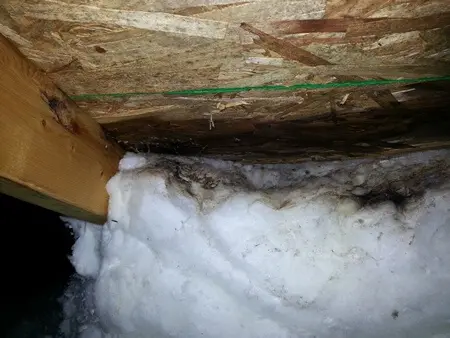
Soffit vent completely blocked by insulation.
Undersized soffit vents
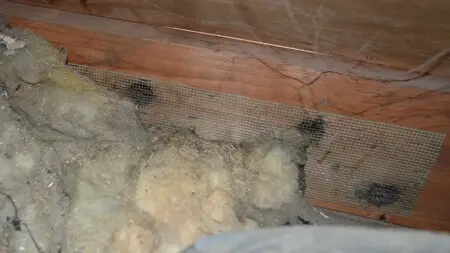
Undersized bird block holes in soffit (blocked by insulation as well)
Heavy mold growth on attic sheathing above undersized soffits
Failed cut back of ridge vent
Ridge vents don’t do much good if they’re entirely blocked by framing. You’d be surprised how often we see this. In many cases, the vent is not entirely blocked, but certainly enough to impede the airflow.
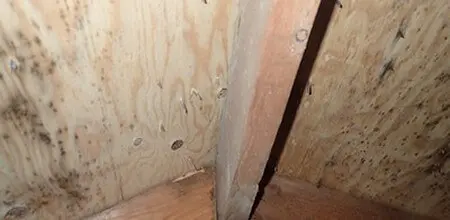
Oops. A ridge vent doesn’t work to well if the sheathing isn’t cutback to allow air flow.
In some attics, traditional soffit venting is impossible
In some homes – there is simply no space for soffit venting. Notice how the gutter is directly in line with the siding, leaving no space for traditional soffit venting. Solutions exist for these scenarios, but they can be expensive.
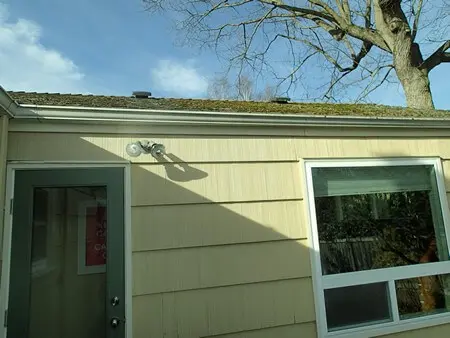
Some older homes have zero soffits /eaves to add venting.
PROBLEM #3. Too much insulation?
Attics are weird. They don’t seem to play by the rules. Why do some attics with zero ventilation have no mold and yet other attic spaces with flawless ventilation are covered in mold growth? Consider the attic below.
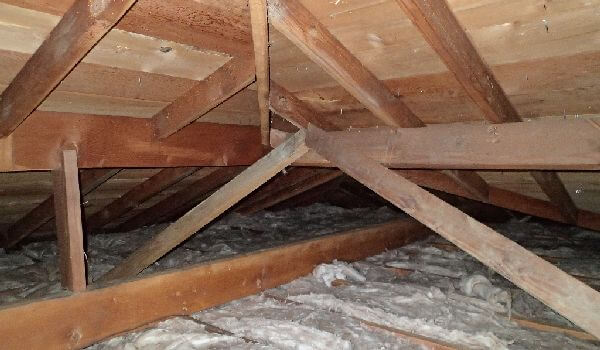
No ventilation, yet no mold growth in the attic…
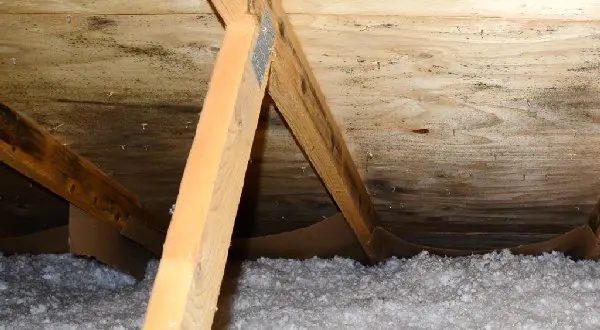
Perfect ventilation, yet mold starting to grow.
Why is this occurring? If all other factors are equal – additional insulation will make mold growth more likely. It’s counter-intuitive, but quite true. In the past, a bit of heat radiated up through the insulation and slightly warmed the roof sheathing. This bump in the temperature brought the surface of the sheathing above the dew point. No dew point, no condensation.
Over the decades the building code has increased the required R-value of attic insulation. With each incremental increase of insulation, less and less heat made it up in to the attic. Great for energy bills, bad for your roof. In many cases, the required insulation level is so high, essentially no heat reaches the sheathing.
No amount of ventilation will help this issue. Bringing in cool, wet winter air into an ice cold attic will hardly dry things out.
The solution?
Air sealing the ceiling. While a bit of radiant heat loss into the attic can prevent condensation, we certainly don’t want water vapor to enter the space. Air sealing dramatically reduces the amount of water vapor from entering the attic.
Lower the indoor RH. Installing constant flow bathroom exhaust fans will reduce the moisture load placed upon the attic. By lowering the RH inside the home, the that makes it into the attic will now have much less moisture. In many cases, these two steps are sufficient to stop the problem.
In a perfect world, we’d do it right from the beginning. Build homes with conditioned attic spaces (no ventilation to the exterior, insulation directly attached to roof sheathing). Unfortunately, this is cost prohibitive in many retrofit scenarios.
How not to build an attic…
Notice anything unusual here? Yep, that is a flat roof completely encompassed by a regular, pitched roof. Why? Our best guess is the builder was forced to chop the top of the roof off the comply with height regulations. The home is located in a neighborhood with views. Likely a neighbor complained of the violation, which resulted in this rather bizarre solution. Surprisingly, the mold growth in the flat section was fairly minor (although there was heavier growth in other areas). Flat roofs are notorious for mold growth. The issue is less related to roof leaks and more due to the lack of air circulation that occurs in low angle or flat roofs. Homes depend upon the stack effect (warm air rising) to push warm, humid air out of the attic space. When a roof is flat, this effect is dramatically reduced and the air stagnates, causing condensation and mold growth.
Treating and venting the flat roof section would be impossible due to the limited access. Therefore, our recommendation was to focus on lowering the interior humidity levels and wait until the roof is due for replacement. At this time, the ventilation should be entirely removed and insulation installed directly on to the roof sheathing. This is referred to as a conditioned attic space and will completely eliminate condensation and mold growth.
This project is particularly challenging because the area where you would normally install a ridge vent is actually designed like a shed roof. A shed roof has a single sloping surface which ends in a vertical peak.
*Heads up – I earn a small commission on sales through Amazon links. This helps cover the expense of running the website (and answering your questions!)
Got a question? Ask it here and we'll post the answer below
Attic HVAC system causing condensation and high humidity which caused mold throughout attic. Mold remediation currently being done throughout whole house. HVAC system and attic to be fixed to reduce humidity and condensation Remediation experts are saying that all mold does not need to be removed as this is not a living space. Apparently cleaned by company but HVAC system has not even been removed from attic. Should attic be thoroughly cleaned and inspector tested?
Yes, the attic mold should be remediated. They are correct in their comment about the attic being outside of the conditioned air space. The mold in the attic is unlikely to affect the indoor air quality. However, it will be difficult to sell the house when a buyer’s home inspector finds the mold. Unfortunately, mold does not fade with time, even if it’s long since stopped growing. We recommend a two part mildicide / encapsulation procedure – it’s far more cost effective than sanding and provides a better finished product. Be careful when collecting bids, as some contractors inflate their prices dramatically and assume customers won’t obtain competing bids.
Is it possible that mold from the attic spreads into the walls?
No. Due to the stack effect (the principle of warm air rising in a home), mold spores in the attic have no downward path in a home. There are rare exceptions where the HVAC system might pull air back into the home. This would require both a leaky cold air return and a missing or damaged furnace filter.
If you’re seeing mold growth on the walls and the attic, it’s either due to a roof leak or two completely separate issues.
We had an inspection done on a home that we made an offer on and they found a small roof leak by the ventilation fan in laundry room which is causing mold. In addition, there were several other areas where moisture is being exposed to the house (leaking plumbing underneath, roof missing drip edge flashing and wood rot on Facia. We are trying to determine if this would be considered enough of a hazard to cancel our contract on the offer if the owner doesn’t repair.
Mold growth in an attic will typically not affect the indoor air quality and your health. This is due to the fact air is continuously moving upward in a home. However, attic mold should not be ignored, as the excess moisture can lead to long term damage to the roof sheathing.
I recommend hiring an inspector or contractor to identify what changes are necessary to stop the water intrusions and address any ventilation issues.
What could dark stripes on ceiling all around perimeter of house be?
This dark staining is due to ghosting, a phenomenon that occurs when dust and soot collects on a wall or ceiling due to condensation. A lack of insulation is the primary culprit. This causes a drop in temperature and in turn, condensation. The condensation causes dust particles to stick to the sheet rock, which eventually leads to staining.
This staining is not a health issue, but it can be tricky to remove. Repainting is usually required. You can prevent future ghosting by adding insulation above the ceiling and/or lowering the humidity in the home.
When was air sealing required by code?
It depends on the state. In Washington, it was required in the 1986 energy code. This does not mean it was widely implemented or verified by code inspectors. I’ve inspected hundreds of attics built much more recently than 1986 that lacked any air sealing. About 10 years ago it became much more commonplace.
I have a exhaust fan in the bathroom I was cleaning it and I noticed that it wasn't venting outside, i have a flat roof and stopped using the bathroom fan i open the window and door. I live in Wilmington Delaware do know anybody in the Wilmington DE.19805 area that can install it the proper way with the proper insulated duct. Like i said i don't know if I have mold on the flat roof attic and im concerned. Thank you.
You are correct to be concerned. A disconnected bath fan can introduce a tremendous amount of humidity into the attic space, causing condensation and mold growth. This is especially problematic with flat roofs, as they suffer from much worse natural ventilation than a regular pitch attic. Usually a handyman is the best type of person to tackle an exhaust fan project. An HVAC contractor could do it, but they’ll charge far more.
I live next to a public works mobile office trailer. They have four vents that point toward my house. Could this be causing the mold growth inside of my attic. The mold is only growing on one side.
It is very unlikely this is contributing to the attic mold in your home. The air coming out of the vents would likely be warmer than the outside air, which would warm your roof and lower the likelihood of condensation. It is actually quite common to see mold growth only on one side of the roof. This is due to shading, either from a north facing aspect or a tree. I recommend assessing your roof ventilation.


